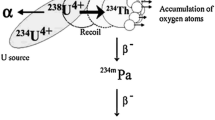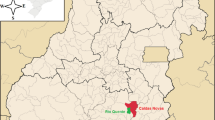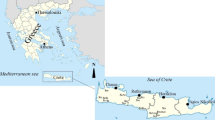Abstract
This research aimed to get information about the uranium and radium activity concentrations in surface and ground water in a semiarid region in Brazil. Mean (and range) activity of 0.46 (0.01–1.8), 0.015 (0.0004–0.066) and 0.32 (0.09–1.32) Bq L− 1 were found for 234U, 235U and 238U, respectively. Uranium radioisotopes account for the higher radioactivity in surface and groundwater, 226Ra was found only in few groundwater samples (0.09–0.61 Bq L− 1). 226Ra/238U (0.15–0.43) and 234U/238U (1.18–1.86) activity ratios are indicative of radioactive disequilibrium in groundwater. Expected effective doses from few water sources can be considered significant if untreated water is used for drinking.





Similar content being viewed by others
Change history
02 June 2021
A Correction to this paper has been published: https://doi.org/10.1007/s10967-021-07790-0
References
UNSCEAR (2000) Sources and effects of ionizing radiation. Volume I: sources. United Nations Scientific Committee on the Effects of Atomic Radiation, New York. http://www.unscear.org/unscear/en/publications/2000_1.html. Accessed 18 Sep 2019
Chen J (2018) A summary of natural radionuclides in canadian public water supply systems. Radiat Environ Med 7:9–11
Chau ND, Dulinski M, Jodlowski P, Nowak J, Rozanski K, Sleziak M, Wachniew P (2011) Natural radioactivity in groundwater, a review. Isot Environ Health Stud 47:415–437
Osmond JK, Cowart JB (1992) Groundwater. In: Ivanovich M, Harmon RS (eds) Uranium-series disequilibrium applications to earth, marine and environmental sciences, 2nd edn. Oxford Science Publications, Oxford
Priestley SC, Payne E, Harrison TE, Post JJ, Shand VEA, Love P, Wohling AJDL (2018) Use of U-isotopes in exploring groundwater flow and inter-aquifer leakage in the south-western margin of the Great Artesian Basin and Arckaringa Basin, central Australia. Appl Geochem. https://doi.org/10.1016/j.apgeochem.2018.10.002
Liu C, Hub B, Jianbo J, Li J, Zhang X, Chen H (2011) Determination of uranium isotopic ratio (235U/238U) using extractive electrospray ionization tandem mass spectrometry. J Anal At Spectrom 26:2045–2051
Bross R, Turpin L, Gauthier-Lafaye F, Holliger P, Siller P (1972) Ocurrence of naturally enriched 235U: implications for plutonium behaviour in natural environments. Geochim Cosmochim Acta 57:1351–1356
Donohue D (2002) Highly selctive and sensitive analytical measurements of trace nuclear materials ensure that secret nuclear activities are not overlooked by inspectors. Anal Chem. https://doi.org/10.1021/ac021909y
Banner JL, Wasserburg GJ, Chen JH, Moore CH (1990) 234U_238U_230Th_232Th systematics in saline groundwaters from central Missouri. Earth Planet Sci Lett 101:296–312
Chkir N, Guendouz A, Zouari K, Ammar FH, Moulla AS (2009) Uranium isotopes in groundwater from the continental intercalaire aquifer in Algerian Tunisian Sahara (North Africa). J Environ Radioact 100:649–656
Cizdziel J, Farmer D, Hodge V, Lindley K, Stetzenbach K (2005) 234U/238U isotope ratios in groundwater from Southern Nevada: a comparison of alpha counting and magnetic sector ICP-MS. Sci Total Environ 350:248–260
Stacey CP, Timothy EP, Jennifer JH, Vincent EAP, Paul S, Andrew JL, Daniel LW (2018) Use of U-isotopes in exploring groundwater flow and inter-aquifer leakage in the south-western margin of the Great Artesian Basin and Arckaringa Basin, central Australia. Appl Geochem 98:331–344
Kigoshi K (1971) Alpha-recoil 234Th: dissolution into water and the 234U/238 U disequilibrium in nature. Science 173:47–48
Ivanovich M (1994) Uranium series disequilibrium: concepts and applications. Radiochim Acta 64:81
Kurttio P, Auvinen A, Salonen L, Saha H, Pekkanen J, Mäkeläinen I, Väisänen SB, Penttilä IM, Komulainen H (2002) Renal effects of uranium in drinking water. Environ Health Perspect. https://doi.org/10.1289/ehp.02110337
Sheppard SC, Sheppard MI, Gallerand MO, Sanipell B (2005) Derivation of ecotoxicity thresholds for uranium. J Environ Radioact 79:55–83
Stehney AF, Lucas HF (1955) Studies on the radium content of humans arising from the natural radium of their environment. In: Proceedings of the international conference on peaceful uses of atomic energy. New York, NY: United Nations, pp 1–13
WHO (2011) Guidelines for drinking-water quality: fourth edition incorporating the first addendum, 4th edn. World Health Organization, Geneva
Kurttio P, Komulainen H, Leino A, Salonen L, Auvinen A, Saha H (2005) Bone as a possible target of chemical toxicity of natural uranium in drinking water. Environ Health Perspect. https://doi.org/10.1289/ehp.7475
Prat O, Vercouter T, Ansoborlo E, Fichet P, Perret P, Kurttio P, Salonen L (2009) Uranium speciation in drinking water from drilled wells in southern Finland and its potential links to health effects. Environ Sci Technol. https://doi.org/10.1021/es803658e
Canu IG, Laurent O, Pires N, Laurirer D, Dublineau I (2011) Health Effects of naturally radioactive water ingestion: the need for enhanced studies. Environ Health Perspect. https://doi.org/10.1289/ehp.1003224
WHO (2018) Management of radioactivity in drinking-water. Geneva: World Health Organization. Licence: CC BY-NC-SA 3.0 IGO
Malanca A, Repetti M, de Macêdo HR (1998) Gross Alpha and Beta activities in Surface and Ground Water of Rio Grande do Norte, Brazil. Appl Radiat Isot 49:893–898
Godoy J, Godoy ML (2006) Natural radioactivity in brazilian groundwater. J Environ Radioact 85:71–83
Silva Filho CA, França EJ (2013) Radioactive risk evaluation of mineral water in the Metropolitan Region of Recife, Northeastern Brazil. J Radioanal Nucl Chem. https://doi.org/10.1007/s10967-012-1993-6
Moura JC (2009) Radioactive pegmatites of the Parelhas region, Rio Grande do Norte, northeast Brazil. Preliminary investigation on radiominerals and radioactive minerals. International nuclear atlantic conference—INAC 2009, Rio de Janeiro, RJ, Brazil, September 27 to October 2, 2009. ISBN: 978-85-99141-03-8
ANA (2012) A Questão da Água no Nordeste. Centro de Gestão e Estudos Estratégicos. Agência Nacional De Águas. CGEE, Brasília
Trolei A, Silva B (2018) Os recursos hídricos do Rio Grande do Norte: uma análise da vulnerabilidade territorial ao colapso no abastecimento de água. Confins. https://doi.org/10.4000/confins.12901
Costa A, Melo JG, Silva FM (2006) Aspectos da salinização das águas do aquifero cristalino no estado do Rio Grande do Norte, nordeste do Basil. Águassubterrâneas 20:67–82
Rojas LV, Santos Junior JA, Corcho-Alvarado JA, Santos Amaral R, Röllin S, Milan MO, Herrero ZF, Francis K, Cavalcanti M, Santos JM (2020) Quality and management status of the drinking water supplies in a semiarid region of Northeastern Brazil. J Environ Sci Health Part A. https://doi.org/10.1080/10934529.2020.1782668
Corcho Alvarado JA, Balsiger B, Rollin S, Jakob A, Burger M (2014) Radioactive and chemical contamination of the water resources in the former uranium mining and milling sites of Mailuu Suu (Kyrgyzstan). J Environ Radioact 138:1–10
Lauria DC, Almeida RM, Sracek O (2004) Behavior of radium, thorium and uranium in groundwater near the Buena Lagoon in the Coastal Zone of the State of Rio de Janeiro. Br Environ Geol 47:11–19. https://doi.org/10.1007/s00254-004-1121-1
Bonotto DM (2004) Doses from 222Rn, 226Ra, and 228Ra in groundwater from Guarani aquifer, South America. J Environ Radioact 76:319–335
Bonotto DM, Bueno TO (2008) The natural radioactivity in Guarani aquifer groundwater, Brazil. AppRadiatIsot 66:1507–1522
Bonotto DM (2011) Natural radionuclides in major aquifer systems of the Parana sedimentary basin, Brazil. Appl Radiat lsot 69:1572–1584
Erika R, Leila SM (2008) Uranium series disequilibria in ground waters from a fractured bedrock aquifer (Morungaba Granitoids—Southern Brazil): implications to the hydrochemical behavior of dissolved U and Ra. Appl Radiat lsot 66:1531–1542
Bonotto DM (2016) The dissolved uranium concentration and 234U/238 U activity ratio in groundwaters from spas of southeastern Brazil. J Environ Radioact. https://doi.org/10.1016/j.jenvrad.2016.03.009
Szabo Z, Depaul VT, Fischer JM, Kraemer TF, Jacobsen E (2012) Occurrence and geochemistry of radium in water from principal drinking-water aquifer systems of the United States. Appl Geochem 27:729–752
Chapman D (1996) Water quality assessments—a guide to use of Biota, sediments and water in environmental monitoring, 2nd edn. Published by F & FN Spon, London
Ueda S, Hasegawa H, Takahu Y, Kondo K (2003) Behavior of uranium undervariousredox conditionsin a shallow brackish lake. J Radioanal Nucl Chem 256:247–252
Chau ND, Dulinski M, Jodlowski P, Nowak J, Rozanski K, Sleziak M, Wachniew P (2011) Natural radioactivity in groundwater, a review. Isot Environ Health Stud. https://doi.org/10.1080/10256016.2011.628123
Acknowledgements
This work was supported by the Conselho Nacional de Desenvolvimento Científico e Tecnológico (CNPq) of Brazil and The World Academy of Science (TWAS) under Grant CNPq/TWS Number 190692/2015-4.
Author information
Authors and Affiliations
Contributions
All authors contributed to the study conception and design. Material preparation, data collection and analysis were performed by Lino Valcarcel Rojas, José Araújo dos Santos Júnior, José Antonio Corcho Alvarado, Marvic Ortueta Milan and Stefan Röllin. The first draft of the manuscript was written by Lino Valcarcel Rojas and all authors commented on previous versions of the manuscript. All authors read and approved the final manuscript.
Corresponding author
Ethics declarations
Conflict of interest
The authors declare that they have no conflict of interest.
Additional information
Publisher's Note
Springer Nature remains neutral with regard to jurisdictional claims in published maps and institutional affiliations.
Rights and permissions
About this article
Cite this article
Rojas, L.V., dos Santos Júnior, J.A., Alvarado, J.A.C. et al. Natural uranium isotopes and 226Ra in surface and groundwater from a basin of a semiarid region in Brazil. J Radioanal Nucl Chem 326, 1081–1089 (2020). https://doi.org/10.1007/s10967-020-07393-1
Received:
Accepted:
Published:
Issue Date:
DOI: https://doi.org/10.1007/s10967-020-07393-1




